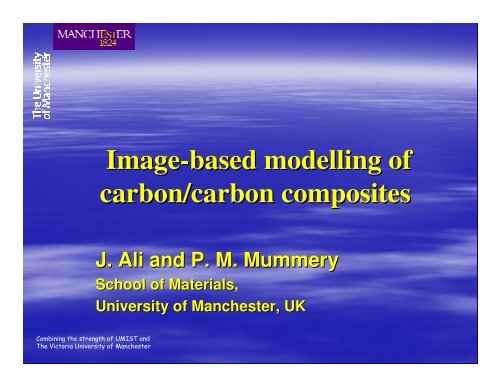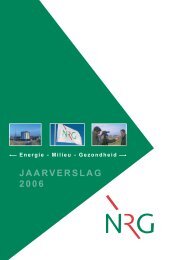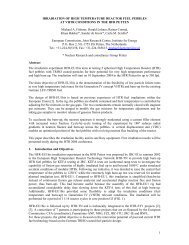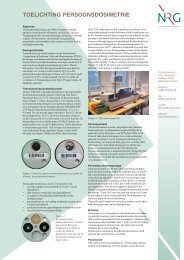Image-based modelling of carbon/carbon composites
Image-based modelling of carbon/carbon composites
Image-based modelling of carbon/carbon composites
You also want an ePaper? Increase the reach of your titles
YUMPU automatically turns print PDFs into web optimized ePapers that Google loves.
<strong>Image</strong>-<strong>based</strong> <strong>modelling</strong> <strong>of</strong><br />
<strong>carbon</strong>/<strong>carbon</strong> <strong>composites</strong><br />
J. Ali and P. M. Mummery<br />
School <strong>of</strong> Materials,<br />
University <strong>of</strong> Manchester, UK<br />
Combining the strength <strong>of</strong> UMIST and<br />
The Victoria University <strong>of</strong> Manchester
Introduction<br />
Objective <strong>of</strong> study<br />
2D woven <strong>composites</strong><br />
Methodology <strong>of</strong> image-<strong>based</strong> (IB) <strong>modelling</strong><br />
– X-ray<br />
Microtomography to FE meshes.<br />
3D Unit cells<br />
FE <strong>modelling</strong> <strong>of</strong> mechanical and thermal behaviour<br />
– Nanoindentation for input mechanical data<br />
– Micro-thermal properties from literature<br />
– Compression test (validation)<br />
– Laser flash test (validation)<br />
Future work on irradiation<br />
Combining the strength <strong>of</strong> UMIST and<br />
The Victoria University <strong>of</strong> Manchester
Objective<br />
Predicting mechanical and thermal properties<br />
– Function <strong>of</strong> architecture, irradiation and temperature (end goal)<br />
– Greater focus on the complex material architectures<br />
– Framework for all classes <strong>of</strong> material with similar structures<br />
ExtreMat<br />
– European Integrated programme<br />
– New materials for extreme environments<br />
Irradiation, temperature, heat flux<br />
C/C Composites<br />
– Restraints and control rods in fission reactors<br />
– Divertor structures in fusion reactors<br />
Combining the strength <strong>of</strong> UMIST and<br />
The Victoria University <strong>of</strong> Manchester
2D Woven C/C Composites<br />
Toyo Tanso CX-27<br />
Graphitised & Un-graphitised conditions<br />
Lamina (X)<br />
(Ishihara, JAEA)<br />
Perpendicular (Y)<br />
Combining the strength <strong>of</strong> UMIST and<br />
The Victoria University <strong>of</strong> Manchester
What is X-ray X<br />
Microtomography?<br />
Non-destructive technique for imaging the<br />
internal structure <strong>of</strong> samples in 3D<br />
Set <strong>of</strong> radiographs <strong>of</strong> sample at many<br />
orientations obtained by rotating it within beam<br />
Read by reconstruction s<strong>of</strong>tware<br />
3D attenuation contrast image <strong>of</strong> object using<br />
standard filtered back-projection algorithm<br />
[1]<br />
[1] Babout et al.: Carbon, 2005, 43, 765-774.<br />
Combining the strength <strong>of</strong> UMIST and<br />
The Victoria University <strong>of</strong> Manchester
What is X-ray X<br />
Microtomography?<br />
3-D D data set<br />
Ability to visualise internal<br />
features non-destructively<br />
Characterise structures<br />
– “Virtual” metallography<br />
Study deformation<br />
processes in situ<br />
FE Modelling<br />
Combining the strength <strong>of</strong> UMIST and<br />
The Victoria University <strong>of</strong> Manchester<br />
Tooth and Filling
X-ray Microtomography Data<br />
Imaging conditions at a low voltage <strong>of</strong> ∼60-70kV and<br />
90-210<br />
210µA, with pixel resolution <strong>of</strong> ~20µm<br />
Graphitised C/C:<br />
Grey Scale image<br />
Porosity<br />
Transverse<br />
shrinkage cracks<br />
Matrix<br />
Fibre(s)<br />
Combining the strength <strong>of</strong> UMIST and<br />
The Victoria University <strong>of</strong> Manchester<br />
200µm
Creating IB FE Meshes<br />
Deduce volume fraction <strong>of</strong> composite phases:<br />
Porosity % - Pore-Master (Porosimeter(<br />
Porosimeter)<br />
– Archimedes (water) displacement test - compared<br />
Fibre % and matrix % - SEM <strong>Image</strong>s<br />
Work out image threshold representative to<br />
volume fraction <strong>of</strong> phase(s)<br />
Mesh generated via Simpleware LTD<br />
Mechanical properties <strong>of</strong> fibres and matrix<br />
determined by Nanoindentation<br />
Thermal properties taken from literature<br />
Combining the strength <strong>of</strong> UMIST and<br />
The Victoria University <strong>of</strong> Manchester<br />
[2]<br />
[2] Ali et al.: ‘<strong>Image</strong>-<strong>based</strong> <strong>modelling</strong> <strong>of</strong> stress/strain behaviour<br />
in <strong>carbon</strong>/<strong>carbon</strong> <strong>composites</strong>’, Energy Materials, 2006.
Microstructural Representation<br />
Transverse<br />
Un-graphitised<br />
C/C composite<br />
Combining the strength <strong>of</strong> UMIST and<br />
The Victoria University <strong>of</strong> Manchester
FE Mesh<br />
Red = Porosity, Blue = Matrix, Yellow = fibres<br />
1mm<br />
Combining the strength <strong>of</strong> UMIST and<br />
The Victoria University <strong>of</strong> Manchester
Unit-cell for comparison<br />
Upgraded to curve architecture [3]<br />
0.5mm<br />
[3] Farooqi et al.: Comp. Mater. Sci., 2006, 37, 361-373.
Micromechanical data<br />
Properties <strong>of</strong> fibres and matrix:<br />
Combining the strength <strong>of</strong> UMIST and<br />
The Victoria University <strong>of</strong> Manchester<br />
GRAPHITISED<br />
Region Indented<br />
Side-<strong>of</strong>-fibres<br />
End-<strong>of</strong>-fibres<br />
Matrix<br />
UN-GRAPHIT.<br />
Region Indented<br />
Side-<strong>of</strong>-fibres<br />
End-<strong>of</strong>-fibres<br />
Matrix<br />
No. <strong>of</strong> Indents<br />
11<br />
3<br />
3<br />
No. <strong>of</strong> Indents<br />
10<br />
3<br />
3<br />
Mean Modulus<br />
(GPa)<br />
7.1 (±1.6)<br />
24.9 (±1.9)<br />
11.4 (±2.7)<br />
Mean Modulus<br />
(GPa)<br />
5.5 (±1.0)<br />
22.8 (±2.1)<br />
7.5 (±1.1)
<strong>Image</strong>s <strong>of</strong> Indents<br />
Matrix less elastic recovery compared to fibres<br />
End-<strong>of</strong>-fibres<br />
(parallel)<br />
Indent marks<br />
in matrix<br />
(Remaining)<br />
Atomic Force Microscope<br />
(AFM)
Compressive Testing<br />
Validate the models with experimental data<br />
Loading<br />
Extensometer<br />
Platen 1<br />
Platen 2<br />
Sample<br />
Cubic samples:<br />
6mm x 6mm x 6mm<br />
Combining the strength <strong>of</strong> UMIST and<br />
The Victoria University <strong>of</strong> Manchester
Stress/strain results<br />
Graphitised C/C composite – lamina direction<br />
80<br />
70<br />
60<br />
Stress (MPa)<br />
50<br />
40<br />
30<br />
20<br />
10<br />
0<br />
Experimental<br />
<strong>Image</strong>-<strong>based</strong><br />
Analytical<br />
Unit-cell<br />
0 0.001 0.002 0.003 0.004 0.005<br />
Strain
Stress/strain results<br />
Graphitised composite – perpendicular direction<br />
100<br />
90<br />
80<br />
70<br />
Stress (MPa)<br />
60<br />
50<br />
40<br />
30<br />
20<br />
10<br />
0<br />
Experimental<br />
<strong>Image</strong>-<strong>based</strong><br />
Analytical<br />
Unit-cell<br />
0 0.04 0.08 0.12 0.16 0.2<br />
Strain
Stress/strain results<br />
Un-graphitised C/C composite – lamina direction<br />
70<br />
60<br />
50<br />
Stress (MPa)<br />
40<br />
30<br />
20<br />
10<br />
0<br />
Experimental<br />
<strong>Image</strong>-<strong>based</strong><br />
Analytical<br />
Unit-cell<br />
0 0.001 0.002 0.003 0.004 0.005 0.006<br />
Strain
Stress/strain results<br />
Un-graphitised composite – perpendicular direction<br />
160<br />
140<br />
120<br />
Stress (MPa)<br />
100<br />
80<br />
60<br />
40<br />
20<br />
0<br />
Experimental<br />
<strong>Image</strong>-<strong>based</strong><br />
Analytical<br />
Unit-cell<br />
0 0.03 0.06 0.09 0.12 0.15<br />
Strain
Shear failure<br />
Lamina direction<br />
Perpendicular direction
Analysis <strong>of</strong> stress/strain curves<br />
Predictions <strong>of</strong> Young’s s modulus, E (GPa(<br />
GPa):<br />
Derived from stress/strain curves<br />
Loaded<br />
Direction<br />
Graphitised<br />
lamina<br />
Graphitised<br />
perpendicular<br />
Un-graphitised<br />
lamina<br />
Un-graphitised<br />
perpendicular<br />
Experimental<br />
22.0<br />
0.6<br />
15.4<br />
1.3<br />
<strong>Image</strong>-<strong>based</strong><br />
16.3<br />
0.5<br />
13.2<br />
1.1<br />
Unit-cell<br />
16.7<br />
2.3<br />
13.0<br />
1.5<br />
Analytical<br />
13.3<br />
8.7<br />
11.2<br />
6.2<br />
Best predictions highlighted in red<br />
Combining the strength <strong>of</strong> UMIST and<br />
The Victoria University <strong>of</strong> Manchester
Summary <strong>of</strong> stress/strain results<br />
Good correlation between both FE models and<br />
experimental curves (valid)<br />
<strong>Image</strong>-<strong>based</strong> models better than analytical and<br />
unit-cells<br />
Unit-cell comparable in lamina direction but<br />
linear – neglect <strong>of</strong> porosity<br />
Comparison <strong>of</strong> image-<strong>based</strong> predictions:<br />
– Un-graphitised model gave better agreement with<br />
experiment than graphitised<br />
– More representative area chosen for mesh<br />
Combining the strength <strong>of</strong> UMIST and<br />
The Victoria University <strong>of</strong> Manchester<br />
Computational power
Thermal Conductivity:<br />
Measurement Principle<br />
Thermal conductivity:<br />
λ = α ρ C p<br />
– α: : thermal diffusivity (Laser flash)<br />
– : : average density<br />
[4]<br />
– C p<br />
: specific heat<br />
Laser flash<br />
– heat pulse on a sample front face<br />
– temperature raise recorded on rear face<br />
T (ºC)<br />
T max<br />
α =<br />
0.136* L<br />
t<br />
1/ 2<br />
[4] Chawla: ‘Ceramic Matrix<br />
t 1/2 time (s) Composites’, Chapman & Hall, 1993.<br />
2
Schematic <strong>of</strong><br />
Laser Flash Rig
Thermal Analysis<br />
Thermal diffusivity measurements converted to<br />
thermal conductivity<br />
– Used to validate FE predictions<br />
Best representative input data taken from<br />
literature<br />
[3]<br />
Steady state FE analysis<br />
Fourier’s s law<br />
Heat flux marks thermal conductivity<br />
Predictions made using:<br />
– <strong>Image</strong>-<strong>based</strong> models<br />
– Unit-cells<br />
Sub-models for 4 classes <strong>of</strong> porosity (A-D) designed by<br />
Farooqi et al.<br />
[3] Farooqi et al.: Comp. Mater. Sci., 2006, 37, 361-373.
Porosity classes<br />
4 Classes <strong>of</strong> porosity identified by optical and<br />
scanning electron microscopy<br />
[5]<br />
Combining the strength <strong>of</strong> UMIST and<br />
The Victoria University <strong>of</strong> Manchester<br />
[5] Puglia et al.: Composites Part A: Applied Sci.<br />
and Manufac., 2004, 35, 223-230.
Thermal results<br />
Graphitised C/C<br />
Composite<br />
Experimental<br />
results (Wm -1 K -1 )<br />
<strong>Image</strong>-<strong>based</strong><br />
model (Wm -1 K -1 )<br />
Unit-cell model<br />
(Wm -1 K -1 )<br />
Un-graphitised C/C<br />
Composite<br />
Experimental<br />
results (Wm -1 K -1 )<br />
<strong>Image</strong>-<strong>based</strong><br />
model (Wm -1 K -1 )<br />
Unit-cell model<br />
(Wm -1 K -1 )<br />
Lamina direction<br />
13.94<br />
15.31<br />
16.81<br />
Lamina direction<br />
9.42<br />
11.32<br />
11.47<br />
Perpendicular<br />
direction<br />
5.04<br />
5.85<br />
7.01<br />
Perpendicular<br />
direction<br />
2.85<br />
3.44<br />
3.95
Optimisation<br />
Optimum input data<br />
Material direction<br />
Graphitised composite:<br />
Lamina<br />
Perpendicular<br />
Average:<br />
Un-graphitised composite:<br />
Lamina<br />
Perpendicular<br />
Average:<br />
Thermal conductivity, k (Wm -1 K -1 )<br />
Fibre parallel<br />
33.50<br />
35.44<br />
34.47<br />
21.92<br />
18.57<br />
20.25<br />
Fibre transverse<br />
3.35<br />
3.54<br />
3.45<br />
2.19<br />
1.86<br />
2.03<br />
Matrix<br />
8.38<br />
8.88<br />
8.63<br />
5.48<br />
4.64<br />
5.06<br />
Input data should be the same for both directions<br />
– Therefore best representative input data is in theory<br />
average <strong>of</strong> the above values for each constituent
Comparison <strong>of</strong> input data<br />
Literature <strong>based</strong> input data versus optimised<br />
Graphitised C/C<br />
Composite<br />
Expt. . (Wm -1 K -1 )<br />
Literature (Wm -1 K -1 )<br />
Optimised (Wm -1 K -1 )<br />
Lamina direction<br />
13.94<br />
15.31<br />
13.22<br />
Perpendicular<br />
direction<br />
5.04<br />
5.85<br />
4.90<br />
Un-graphitised C/C<br />
Composite<br />
Expt. . (Wm -1 K -1 )<br />
Literature (Wm -1 K -1 )<br />
Optimised (Wm -1 K -1 )<br />
Lamina direction<br />
9.42<br />
11.32<br />
8.70<br />
Perpendicular<br />
direction<br />
2.85<br />
3.44<br />
3.10<br />
Combining the strength <strong>of</strong> UMIST and<br />
The Victoria University <strong>of</strong> Manchester
Summary <strong>of</strong> thermal results<br />
<strong>Image</strong>-<strong>based</strong> models showed superior agreement with<br />
experimental data<br />
– Slight over-prediction<br />
– Literature input data questionable, optimised input data better<br />
<strong>Image</strong>-<strong>based</strong> models gives truer representation <strong>of</strong><br />
composite structure<br />
Unit-cell <strong>based</strong> on idealisations <strong>of</strong> composite<br />
microstructure<br />
Difference lies in consideration <strong>of</strong> porosity<br />
Unit-cell main weakness in perpendicular direction<br />
– Thin laminate structure
Application <strong>of</strong> framework<br />
Materials under investigation:<br />
NB-31 3D C/C Composite<br />
B0-27 2D SIC/SIC Composite<br />
SGL 2D C/C Composite<br />
Combining the strength <strong>of</strong> UMIST and<br />
The Victoria University <strong>of</strong> Manchester
Combining the strength <strong>of</strong> UMIST and<br />
The Victoria University <strong>of</strong> Manchester<br />
Conclusion<br />
Comparison <strong>of</strong> FE techniques for woven <strong>composites</strong><br />
Providing useful initial results<br />
Overall results indicate image-<strong>based</strong> models better at<br />
predicting mechanical & thermal behaviour<br />
<strong>Image</strong>-<strong>based</strong> meshes account for complex network <strong>of</strong><br />
pores in structure<br />
FE analysis complicated due to stress shielding large pores<br />
More difficult to assign truer properties<br />
Unit-cells <strong>based</strong> on idealisations <strong>of</strong> composite<br />
microstructure<br />
Truer properties<br />
Thinness main weakness
Future work<br />
Un-irradiated predictions completed<br />
Shows potential for predicting irradiation<br />
behaviour using IB FE meshes<br />
Tomography scans <strong>of</strong> irradiated materials<br />
Other alternatives similarities with thermal oxidation<br />
Need irradiation input data:<br />
Fibres & Matrix<br />
History<br />
Porosity and constituent dimensional changes<br />
under irradiation already accounted<br />
Irradiation sub-routine developed for graphite<br />
Combining the strength <strong>of</strong> UMIST and<br />
The Victoria University <strong>of</strong> Manchester<br />
May eventually be applicable to <strong>carbon</strong> <strong>composites</strong>
References<br />
[1] L. Babout, , P. M. Mummery, T. J. Marrow, A. Tzelepi,<br />
P. J. Withers: Carbon, , 2005, 43, , 765-774.<br />
774.<br />
[2] J. Ali, C. Berre and P. M. Mummery: ‘<strong>Image</strong>-<strong>based</strong><br />
<strong>modelling</strong> <strong>of</strong> stress/strain behaviour in <strong>carbon</strong>/<strong>carbon</strong><br />
<strong>composites</strong>’, , accepted for publication in Energy<br />
Materials<br />
[3] J. K. Farooqi, , M. A. Sheikh: Comp. Mater. Sci., , 2006,<br />
37, , 361-373.<br />
373.<br />
[4] K. K. Chawla, ‘Ceramic Matrix Composites’, , Chapman<br />
& Hall, 1993.<br />
[5] P. Del Puglia, M .A. Shiekh, , D. R. Hayburst:<br />
Composites Part A: Applied Sci. . and Manufac., , 2004,<br />
35, , 223-230.<br />
230.<br />
Combining the strength <strong>of</strong> UMIST and<br />
The Victoria University <strong>of</strong> Manchester
Acknowledgements<br />
EPSRC - Funding<br />
AMEC NNC - Funding<br />
Dr Ishihara, JAEA - Supplying samples<br />
Combining the strength <strong>of</strong> UMIST and<br />
The Victoria University <strong>of</strong> Manchester





